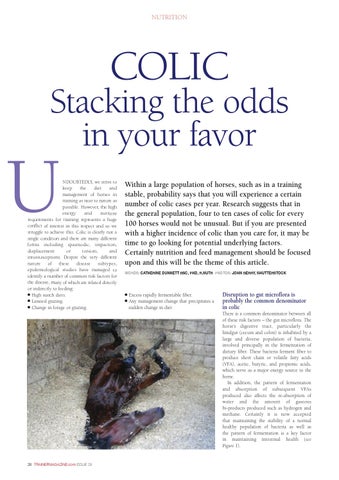COLIC NA ISSUE 29_Jerkins feature.qxd 25/07/2013 13:56 Page 1
NUTRITION
COLIC
Stacking the odds in your favor
U
NDOUBTEDLY, we strive to keep the diet and management of horses in training as near to nature as possible. However, the high energy and nutrient requirements for training represents a huge conflict of interest in this respect and so we struggle to achieve this. Colic is clearly not a single condition and there are many different forms including spasmodic, impaction, displacement or torsion, and intussusceptions. Despite the very different nature of these disease subtypes, epidemiological studies have managed to identify a number of common risk factors for the disease, many of which are related directly or indirectly to feeding: l High starch diets. l Limited grazing. l Change in forage or grazing.
Within a large population of horses, such as in a training stable, probability says that you will experience a certain number of colic cases per year. Research suggests that in the general population, four to ten cases of colic for every 100 horses would not be unusual. But if you are presented with a higher incidence of colic than you care for, it may be time to go looking for potential underlying factors. Certainly nutrition and feed management should be focused upon and this will be the theme of this article. WORDS: CatheRine Dunnett BSC, PhD, R.nutR PhOtOS: JOhn BeRRY, ShutteRStOCK
l l
Excess rapidly fermentable fiber. Any management change that precipitates a sudden change in diet
Disruption to gut microflora is probably the common denominator in colic There is a common denominator between all of these risk factors – the gut microflora. The horse’s digestive tract, particularly the hindgut (cecum and colon) is inhabited by a large and diverse population of bacteria, involved principally in the fermentation of dietary fiber. These bacteria ferment fiber to produce short chain or volatile fatty acids (VFA), acetic, butyric, and propionic acids, which serve as a major energy source to the horse. In addition, the pattern of fermentation and absorption of subsequent VFAs produced also affects the re-absorption of water and the amount of gaseous bi-products produced such as hydrogen and methane. Certainly it is now accepted that maintaining the stability of a normal healthy population of bacteria as well as the pattern of fermentation is a key factor in maintaining intestinal health (see Figure 1).
26 TRAINERMAGAZINE.com ISSUE 29
